Deck 4: Applications of Differentiation
Question
Question
Question
Question
Question
Question
Question
Question
Question
Question
Question
Question
Question
Question
Question
Question
Question
Question
Question
Question
Question
Question
Question
Question
Question
Question
Question
Question
Question
Question
Question
Question
Question
Question
Question
Question
Question
Question
Question
Question
Question
Question
Question
Question
Question
Question
Question
Question
Question
Question
Question
Question
Question
Question
Question
Question
Question
Question
Question
Question
Question
Question
Question
Question
Question
Question
Question
Question

Unlock Deck
Sign up to unlock the cards in this deck!
Unlock Deck
Unlock Deck
1/68
Play
Full screen (f)
Deck 4: Applications of Differentiation
1
A piece of wire 10 m long is cut into two pieces. One piece is bent into a square and the other is bent into an equilateral triangle. How should the wire be cut for the square so that the total area enclosed is a minimum? Round your answer to the nearest hundredth.
A)4.35 m
B)3.25 m
C)0 m
D)5.35 m
E)4.4 m
A)4.35 m
B)3.25 m
C)0 m
D)5.35 m
E)4.4 m
4.35 m
2
The sum of two positive numbers is  . What is the smallest possible value of the sum of their squares?
. What is the smallest possible value of the sum of their squares?
 . What is the smallest possible value of the sum of their squares?
. What is the smallest possible value of the sum of their squares?
3
Find the point on the line  that is closest to the origin.
that is closest to the origin.
A)
B)
C)
D)
E)
 that is closest to the origin.
that is closest to the origin.A)

B)

C)

D)

E)


4
Find the most general antiderivative of the function. 


Unlock Deck
Unlock for access to all 68 flashcards in this deck.
Unlock Deck
k this deck
5
A car braked with a constant deceleration of 40  , producing skid marks measuring 60 ft before coming to a stop. How fast was the car traveling when the brakes were first applied?
, producing skid marks measuring 60 ft before coming to a stop. How fast was the car traveling when the brakes were first applied?
 , producing skid marks measuring 60 ft before coming to a stop. How fast was the car traveling when the brakes were first applied?
, producing skid marks measuring 60 ft before coming to a stop. How fast was the car traveling when the brakes were first applied?
Unlock Deck
Unlock for access to all 68 flashcards in this deck.
Unlock Deck
k this deck
6
Find the most general antiderivative of the function. 
A)
B)
C)
D)
E)

A)

B)

C)

D)

E)


Unlock Deck
Unlock for access to all 68 flashcards in this deck.
Unlock Deck
k this deck
7
A woman at a point A on the shore of a circular lake with radius  wants to arrive at the point C diametrically opposite on the other side of the lake in the shortest possible time. She can walk at the rate of
wants to arrive at the point C diametrically opposite on the other side of the lake in the shortest possible time. She can walk at the rate of  and row a boat at
and row a boat at  . How should she proceed? (Find
. How should she proceed? (Find  ). Round the result, if necessary, to the nearest hundredth.
). Round the result, if necessary, to the nearest hundredth. 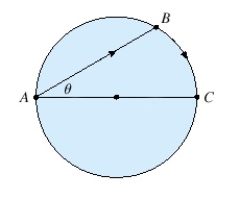
A) radians
radians
B)She should row from point A to point C radians
C) radians
radians
D) radians
radians
E)She should walk around the lake from point A to point C.
 wants to arrive at the point C diametrically opposite on the other side of the lake in the shortest possible time. She can walk at the rate of
wants to arrive at the point C diametrically opposite on the other side of the lake in the shortest possible time. She can walk at the rate of  and row a boat at
and row a boat at  . How should she proceed? (Find
. How should she proceed? (Find  ). Round the result, if necessary, to the nearest hundredth.
). Round the result, if necessary, to the nearest hundredth. 
A)
 radians
radiansB)She should row from point A to point C radians
C)
 radians
radiansD)
 radians
radiansE)She should walk around the lake from point A to point C.

Unlock Deck
Unlock for access to all 68 flashcards in this deck.
Unlock Deck
k this deck
8
Given that the graph of f passes through the point (4, 69) and that the slope of its tangent line at  is
is  , find f (1) .
, find f (1) .
A)11
B)0
C)6
D)12
E)1
 is
is  , find f (1) .
, find f (1) .A)11
B)0
C)6
D)12
E)1

Unlock Deck
Unlock for access to all 68 flashcards in this deck.
Unlock Deck
k this deck
9
Use Newton's method with the specified initial approximation  to find
to find  , the third approximation to the root of the given equation. (Round your answer to four decimal places.)
, the third approximation to the root of the given equation. (Round your answer to four decimal places.) 
A)
B)
C)
D)
E)
 to find
to find  , the third approximation to the root of the given equation. (Round your answer to four decimal places.)
, the third approximation to the root of the given equation. (Round your answer to four decimal places.) 
A)

B)

C)

D)

E)


Unlock Deck
Unlock for access to all 68 flashcards in this deck.
Unlock Deck
k this deck
10
Find the position function of a particle moving along a coordinate line that satisfies the given conditions.  , s (0) = 5, v (0) = 0
, s (0) = 5, v (0) = 0
 , s (0) = 5, v (0) = 0
, s (0) = 5, v (0) = 0
Unlock Deck
Unlock for access to all 68 flashcards in this deck.
Unlock Deck
k this deck
11
Find
f.
f.


Unlock Deck
Unlock for access to all 68 flashcards in this deck.
Unlock Deck
k this deck
12
Use Newton's method to approximate the given number correct to eight decimal places. 
A)
B)
C)
D)
E)

A)

B)

C)

D)

E)


Unlock Deck
Unlock for access to all 68 flashcards in this deck.
Unlock Deck
k this deck
13
Use Newton's method with the specified initial approximation  to find
to find  , the third approximation to the root of the given equation. (Round your answer to four decimal places.)
, the third approximation to the root of the given equation. (Round your answer to four decimal places.) 
A)
B)
C)
D)
E)
 to find
to find  , the third approximation to the root of the given equation. (Round your answer to four decimal places.)
, the third approximation to the root of the given equation. (Round your answer to four decimal places.) 
A)

B)

C)

D)

E)


Unlock Deck
Unlock for access to all 68 flashcards in this deck.
Unlock Deck
k this deck
14
A particle is moving with the given data. Find the position of the particle.  ,
, 
A)
B)
C)
D)
E)
 ,
, 
A)

B)

C)

D)

E)


Unlock Deck
Unlock for access to all 68 flashcards in this deck.
Unlock Deck
k this deck
15
What constant acceleration is required to increase the speed of a car from 20 ft/s to 45 ft/s in  s?
s?
 s?
s?
Unlock Deck
Unlock for access to all 68 flashcards in this deck.
Unlock Deck
k this deck
16
Use Newton's method with the specified initial approximation  to find
to find  , the third approximation to the root of the given equation. (Give your answer to four decimal places.)
, the third approximation to the root of the given equation. (Give your answer to four decimal places.) 
 to find
to find  , the third approximation to the root of the given equation. (Give your answer to four decimal places.)
, the third approximation to the root of the given equation. (Give your answer to four decimal places.) 

Unlock Deck
Unlock for access to all 68 flashcards in this deck.
Unlock Deck
k this deck
17
Find the position function of a particle moving along a coordinate line that satisfies the given condition.  , s(1) = -1
, s(1) = -1
 , s(1) = -1
, s(1) = -1
Unlock Deck
Unlock for access to all 68 flashcards in this deck.
Unlock Deck
k this deck
18
Use Newton's method to approximate the indicated root of  in the interval
in the interval  , correct to six decimal places.Use
, correct to six decimal places.Use  as the initial approximation.
as the initial approximation.
 in the interval
in the interval  , correct to six decimal places.Use
, correct to six decimal places.Use  as the initial approximation.
as the initial approximation.
Unlock Deck
Unlock for access to all 68 flashcards in this deck.
Unlock Deck
k this deck
19
Find the most general antiderivative of the function. 


Unlock Deck
Unlock for access to all 68 flashcards in this deck.
Unlock Deck
k this deck
20
Find two positive numbers whose product is  and whose sum is a minimum.
and whose sum is a minimum.
A)
B)3, 48
C)
D)6, 24
E)2, 72
 and whose sum is a minimum.
and whose sum is a minimum.A)

B)3, 48
C)

D)6, 24
E)2, 72

Unlock Deck
Unlock for access to all 68 flashcards in this deck.
Unlock Deck
k this deck
21
Use the guidelines of this section to sketch the curve.  Select the graph of the curve.
Select the graph of the curve.
A)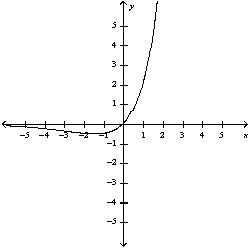
B)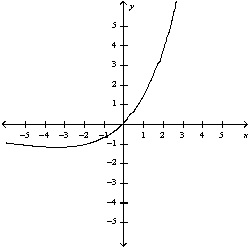
C)
D)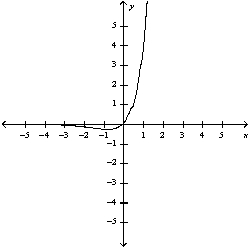
E)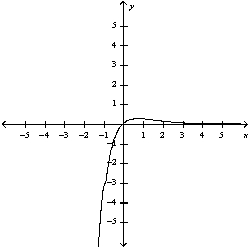
 Select the graph of the curve.
Select the graph of the curve.A)

B)

C)

D)

E)


Unlock Deck
Unlock for access to all 68 flashcards in this deck.
Unlock Deck
k this deck
22
What is the minimum vertical distance between the parabolas  and
and  ?
?
 and
and  ?
?
Unlock Deck
Unlock for access to all 68 flashcards in this deck.
Unlock Deck
k this deck
23
Use the guidelines of this section to sketch the curve.  Select the graph of the curve.
Select the graph of the curve.
A)
B)
C)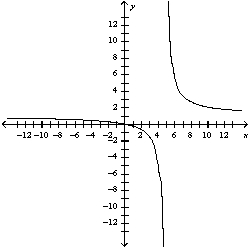
D)
E)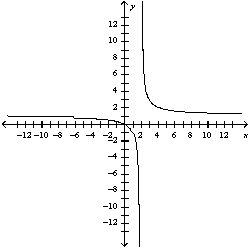
 Select the graph of the curve.
Select the graph of the curve.A)

B)

C)

D)

E)


Unlock Deck
Unlock for access to all 68 flashcards in this deck.
Unlock Deck
k this deck
24
A steel pipe is being carried down a hallway 14 ft wide. At the end of the hall there is a right-angled turn into a narrower hallway 6 ft wide. What is the length of the longest pipe that can be carried horizontally around the corner? 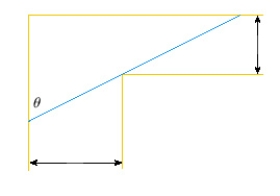


Unlock Deck
Unlock for access to all 68 flashcards in this deck.
Unlock Deck
k this deck
25
Given  .(a) Find the intervals on which f is increasing or decreasing.(b) Find the relative maxima and relative minima of f.
.(a) Find the intervals on which f is increasing or decreasing.(b) Find the relative maxima and relative minima of f.
A)(a) Increasing on ,
,
Decreasing on

(b) Rel. max.
B)(a) Increasing on
(b) None
C)(a) Decreasing on
(b) None
D)(a) Increasing on ,
,
Decreasing on

(b) Rel. min.
 .(a) Find the intervals on which f is increasing or decreasing.(b) Find the relative maxima and relative minima of f.
.(a) Find the intervals on which f is increasing or decreasing.(b) Find the relative maxima and relative minima of f.A)(a) Increasing on
 ,
,Decreasing on

(b) Rel. max.

B)(a) Increasing on

(b) None
C)(a) Decreasing on

(b) None
D)(a) Increasing on
 ,
,Decreasing on

(b) Rel. min.


Unlock Deck
Unlock for access to all 68 flashcards in this deck.
Unlock Deck
k this deck
26
The graph of the derivative  of a continuous function f is shown. On what intervals is f decreasing?
of a continuous function f is shown. On what intervals is f decreasing?  .
.
A)
B)
C)
D)
E)None of these
 of a continuous function f is shown. On what intervals is f decreasing?
of a continuous function f is shown. On what intervals is f decreasing?  .
.A)

B)

C)

D)

E)None of these

Unlock Deck
Unlock for access to all 68 flashcards in this deck.
Unlock Deck
k this deck
27
Use the guidelines of this section to sketch the curve.  Select the graph of the curve.
Select the graph of the curve.
A)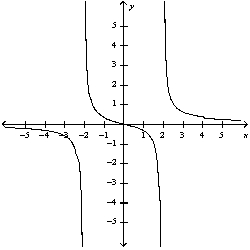
B)
C)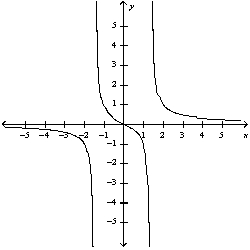
D)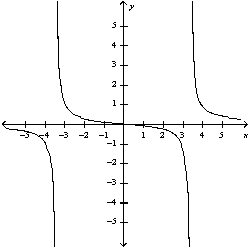
E)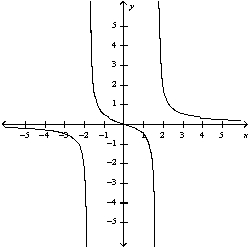
 Select the graph of the curve.
Select the graph of the curve.A)

B)

C)

D)

E)


Unlock Deck
Unlock for access to all 68 flashcards in this deck.
Unlock Deck
k this deck
28
Determine where the graph of the function  is concave upward and where it is concave downward. Also, find all inflection points of the function.
is concave upward and where it is concave downward. Also, find all inflection points of the function.
A)CU on , CD on
, CD on
 ,
,
IP

B)CU on , CD on
, CD on
 ,
,
IP

C)CU on , CD on
, CD on
 ,
,
IP

D)CU on , CD on
, CD on
 ,
,
IP

 is concave upward and where it is concave downward. Also, find all inflection points of the function.
is concave upward and where it is concave downward. Also, find all inflection points of the function.A)CU on
 , CD on
, CD on ,
,IP

B)CU on
 , CD on
, CD on ,
,IP

C)CU on
 , CD on
, CD on ,
,IP

D)CU on
 , CD on
, CD on ,
,IP


Unlock Deck
Unlock for access to all 68 flashcards in this deck.
Unlock Deck
k this deck
29
Use the guidelines of this section to sketch the curve.  Select the graph of the curve.
Select the graph of the curve.
A)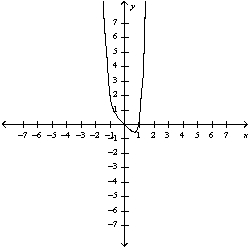
B)
C)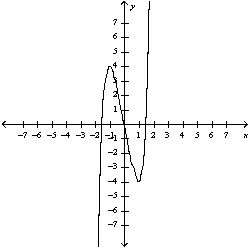
D)
E)
 Select the graph of the curve.
Select the graph of the curve.A)

B)

C)

D)

E)


Unlock Deck
Unlock for access to all 68 flashcards in this deck.
Unlock Deck
k this deck
30
Find an equation of the line through the point  that cuts off the least area from the first quadrant.
that cuts off the least area from the first quadrant.
 that cuts off the least area from the first quadrant.
that cuts off the least area from the first quadrant.
Unlock Deck
Unlock for access to all 68 flashcards in this deck.
Unlock Deck
k this deck
31
Find the maximum or minimum point(s) of the function. 
A)
B)
C)
D)
E)

A)

B)

C)

D)

E)


Unlock Deck
Unlock for access to all 68 flashcards in this deck.
Unlock Deck
k this deck
32
Determine where the graph of  is concave upward and where it is concave downward. Also, find all inflection points of the function.
is concave upward and where it is concave downward. Also, find all inflection points of the function.
A)concave downward: and
and
 , concave upward:
, concave upward:
 and
and
 ; inflection points:
; inflection points:
 and
and

B)concave downward: and
and
 , concave upward:
, concave upward:
 and
and
 ; inflection points:
; inflection points:
 and
and

C)concave downward: nowhere, concave upward: and
and
 ; inflection points: none
; inflection points: none
D)concave downward: and
and
 , concave upward: nowhere; inflection points: none
, concave upward: nowhere; inflection points: none
 is concave upward and where it is concave downward. Also, find all inflection points of the function.
is concave upward and where it is concave downward. Also, find all inflection points of the function.A)concave downward:
 and
and , concave upward:
, concave upward: and
and ; inflection points:
; inflection points: and
and
B)concave downward:
 and
and , concave upward:
, concave upward: and
and ; inflection points:
; inflection points: and
and
C)concave downward: nowhere, concave upward:
 and
and ; inflection points: none
; inflection points: noneD)concave downward:
 and
and , concave upward: nowhere; inflection points: none
, concave upward: nowhere; inflection points: none
Unlock Deck
Unlock for access to all 68 flashcards in this deck.
Unlock Deck
k this deck
33
A farmer with 710 ft of fencing wants to enclose a rectangular area and then divide it into four pens with fencing parallel to one side of the rectangle. What is the largest possible total area of the four pens?

Unlock Deck
Unlock for access to all 68 flashcards in this deck.
Unlock Deck
k this deck
34
Given  .(a) Find the intervals on which f is increasing or decreasing.(b) Find the relative maxima and relative minima of f.
.(a) Find the intervals on which f is increasing or decreasing.(b) Find the relative maxima and relative minima of f.
A)(a) Increasing on ,
,
Decreasing on

(b) Rel. max.
B)(a) Increasing on ,
,
Decreasing on

(b) Rel. min.
C)(a) Increasing on ,
,
Decreasing on

(b) Rel. max.
D)(a) Increasing on ,
,
Decreasing on

(b) Rel. min.
 .(a) Find the intervals on which f is increasing or decreasing.(b) Find the relative maxima and relative minima of f.
.(a) Find the intervals on which f is increasing or decreasing.(b) Find the relative maxima and relative minima of f.A)(a) Increasing on
 ,
,Decreasing on

(b) Rel. max.

B)(a) Increasing on
 ,
,Decreasing on

(b) Rel. min.

C)(a) Increasing on
 ,
,Decreasing on

(b) Rel. max.

D)(a) Increasing on
 ,
,Decreasing on

(b) Rel. min.


Unlock Deck
Unlock for access to all 68 flashcards in this deck.
Unlock Deck
k this deck
35
Given  .(a) Find the intervals on which f is increasing or decreasing.(b) Find the relative maxima and relative minima of f.
.(a) Find the intervals on which f is increasing or decreasing.(b) Find the relative maxima and relative minima of f.
A)(a) Increasing on and
and
 , decreasing on
, decreasing on

(b) Rel. max. ,
,
Rel) min.
B)(a) Increasing on and
and
 , decreasing on
, decreasing on
 and
and

(b) Rel. max. ,
,
Rel) min.
C)(a) Increasing on , decreasing on
, decreasing on
 and
and

(b) Rel. max. ,
,
Rel) min.
D)(a) Increasing on and
and
 decreasing on
decreasing on
 and
and

(b) Rel. max. ,
,
Rel) min.
 .(a) Find the intervals on which f is increasing or decreasing.(b) Find the relative maxima and relative minima of f.
.(a) Find the intervals on which f is increasing or decreasing.(b) Find the relative maxima and relative minima of f.A)(a) Increasing on
 and
and , decreasing on
, decreasing on
(b) Rel. max.
 ,
,Rel) min.

B)(a) Increasing on
 and
and , decreasing on
, decreasing on and
and
(b) Rel. max.
 ,
,Rel) min.

C)(a) Increasing on
 , decreasing on
, decreasing on and
and
(b) Rel. max.
 ,
,Rel) min.

D)(a) Increasing on
 and
and decreasing on
decreasing on and
and
(b) Rel. max.
 ,
,Rel) min.


Unlock Deck
Unlock for access to all 68 flashcards in this deck.
Unlock Deck
k this deck
36
Use the guidelines of this section to sketch the curve.  Select the graph of the curve.
Select the graph of the curve.
A)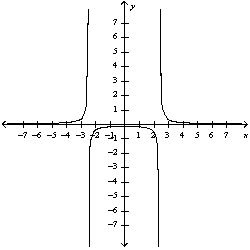
B)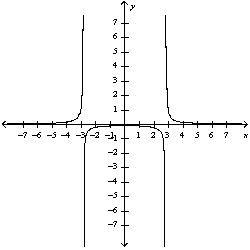
C)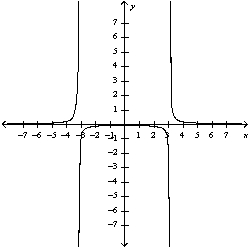
D)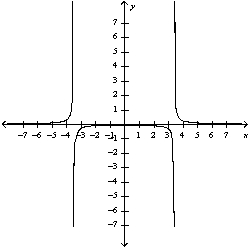
E)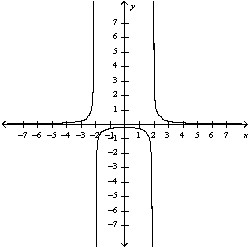
 Select the graph of the curve.
Select the graph of the curve.A)

B)

C)

D)

E)


Unlock Deck
Unlock for access to all 68 flashcards in this deck.
Unlock Deck
k this deck
37
Determine where the graph of the function  is concave upward and where it is concave downward. Also, find all inflection points of the function.
is concave upward and where it is concave downward. Also, find all inflection points of the function.
A)CU on , CD on
, CD on
 ,
,
IP

B)CU on , CD on
, CD on
 and
and

IP
 and
and

C)CU on , CD on
, CD on
 ,
,
IP

D)CU on , CD on
, CD on
 ,
,
IP

 is concave upward and where it is concave downward. Also, find all inflection points of the function.
is concave upward and where it is concave downward. Also, find all inflection points of the function.A)CU on
 , CD on
, CD on ,
,IP

B)CU on
 , CD on
, CD on and
and
IP
 and
and
C)CU on
 , CD on
, CD on ,
,IP

D)CU on
 , CD on
, CD on ,
,IP


Unlock Deck
Unlock for access to all 68 flashcards in this deck.
Unlock Deck
k this deck
38
Use the Second Derivative Test to find the relative extrema, if any, of the function  .
.
A)Rel. max. , rel. min.
, rel. min. 
B)Rel. max. , rel. min.
, rel. min. 
C)Rel. max. , rel. min.
, rel. min. 
D)Rel. max. , rel. min.
, rel. min. 
 .
.A)Rel. max.
 , rel. min.
, rel. min. 
B)Rel. max.
 , rel. min.
, rel. min. 
C)Rel. max.
 , rel. min.
, rel. min. 
D)Rel. max.
 , rel. min.
, rel. min. 

Unlock Deck
Unlock for access to all 68 flashcards in this deck.
Unlock Deck
k this deck
39
Find the maximum area of a rectangle that can be circumscribed about a given rectangle with length L = 8 and width W = 3. 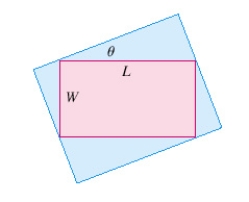


Unlock Deck
Unlock for access to all 68 flashcards in this deck.
Unlock Deck
k this deck
40
Given  .(a) Find the intervals on which f is increasing or decreasing.(b) Find the relative maxima and relative minima of f.
.(a) Find the intervals on which f is increasing or decreasing.(b) Find the relative maxima and relative minima of f.
A)(a) Increasing on and
and
 decreasing on
decreasing on

(b) Rel. max. ,
,
Rel) min.
B)(a) Increasing on , decreasing on
, decreasing on
 and
and

(b) Rel. max. ,
,
Rel) min.
C)(a) Increasing on and
and
 decreasing on
decreasing on

(b) Rel. max. ,
,
Rel) min.
D)(a) Increasing on , decreasing on
, decreasing on
 and
and

(b) Rel. max. ,
,
Rel) min.
 .(a) Find the intervals on which f is increasing or decreasing.(b) Find the relative maxima and relative minima of f.
.(a) Find the intervals on which f is increasing or decreasing.(b) Find the relative maxima and relative minima of f.A)(a) Increasing on
 and
and decreasing on
decreasing on
(b) Rel. max.
 ,
,Rel) min.

B)(a) Increasing on
 , decreasing on
, decreasing on and
and
(b) Rel. max.
 ,
,Rel) min.

C)(a) Increasing on
 and
and decreasing on
decreasing on
(b) Rel. max.
 ,
,Rel) min.

D)(a) Increasing on
 , decreasing on
, decreasing on and
and
(b) Rel. max.
 ,
,Rel) min.


Unlock Deck
Unlock for access to all 68 flashcards in this deck.
Unlock Deck
k this deck
41
Verify that the function satisfies the three hypotheses of Rolle's Theorem on the given interval. Then find all numbers c that satisfy the conclusion of Rolle's Theorem.  ,
, 
A)None of these
B) ,
, 
C) ,
, 
D) ,
, 
E) ,
, 
 ,
, 
A)None of these
B)
 ,
, 
C)
 ,
, 
D)
 ,
, 
E)
 ,
, 

Unlock Deck
Unlock for access to all 68 flashcards in this deck.
Unlock Deck
k this deck
42
Find the absolute maximum and absolute minimum values, if any, of the function  on
on  .
.
A)Abs. max. abs. min.
abs. min. 
B)Abs. max. abs. min.
abs. min. 
C)Abs. max. abs. min.
abs. min. 
D)Abs. max. abs. min.
abs. min. 
 on
on  .
.A)Abs. max.
 abs. min.
abs. min. 
B)Abs. max.
 abs. min.
abs. min. 
C)Abs. max.
 abs. min.
abs. min. 
D)Abs. max.
 abs. min.
abs. min. 

Unlock Deck
Unlock for access to all 68 flashcards in this deck.
Unlock Deck
k this deck
43
Find the absolute maximum and absolute minimum values, if any, of the function ![<strong>Find the absolute maximum and absolute minimum values, if any, of the function on [0, 25]</strong> A)Abs. max. abs. min. B)Abs. max. abs. min. C)Abs. max. abs. min. D)Abs. max. abs. min.](https://d2lvgg3v3hfg70.cloudfront.net/TB8390/11eb7c01_170c_379b_acd2_49a3b1710667_TB8390_11.jpg) on [0, 25]
on [0, 25]
A)Abs. max.![<strong>Find the absolute maximum and absolute minimum values, if any, of the function on [0, 25]</strong> A)Abs. max. abs. min. B)Abs. max. abs. min. C)Abs. max. abs. min. D)Abs. max. abs. min.](https://d2lvgg3v3hfg70.cloudfront.net/TB8390/11eb7c01_170c_379c_acd2_05207a7796b5_TB8390_11.jpg) abs. min.
abs. min. ![<strong>Find the absolute maximum and absolute minimum values, if any, of the function on [0, 25]</strong> A)Abs. max. abs. min. B)Abs. max. abs. min. C)Abs. max. abs. min. D)Abs. max. abs. min.](https://d2lvgg3v3hfg70.cloudfront.net/TB8390/11eb7c01_170c_5ead_acd2_2d64255f16ef_TB8390_11.jpg)
B)Abs. max.![<strong>Find the absolute maximum and absolute minimum values, if any, of the function on [0, 25]</strong> A)Abs. max. abs. min. B)Abs. max. abs. min. C)Abs. max. abs. min. D)Abs. max. abs. min.](https://d2lvgg3v3hfg70.cloudfront.net/TB8390/11eb7c01_170c_5eae_acd2_17de230dc2bb_TB8390_11.jpg) abs. min.
abs. min. ![<strong>Find the absolute maximum and absolute minimum values, if any, of the function on [0, 25]</strong> A)Abs. max. abs. min. B)Abs. max. abs. min. C)Abs. max. abs. min. D)Abs. max. abs. min.](https://d2lvgg3v3hfg70.cloudfront.net/TB8390/11eb7c01_170c_5eaf_acd2_5f8f5ee0b204_TB8390_11.jpg)
C)Abs. max.![<strong>Find the absolute maximum and absolute minimum values, if any, of the function on [0, 25]</strong> A)Abs. max. abs. min. B)Abs. max. abs. min. C)Abs. max. abs. min. D)Abs. max. abs. min.](https://d2lvgg3v3hfg70.cloudfront.net/TB8390/11eb7c01_170c_84c0_acd2_e13b8bf09bd9_TB8390_11.jpg) abs. min.
abs. min. ![<strong>Find the absolute maximum and absolute minimum values, if any, of the function on [0, 25]</strong> A)Abs. max. abs. min. B)Abs. max. abs. min. C)Abs. max. abs. min. D)Abs. max. abs. min.](https://d2lvgg3v3hfg70.cloudfront.net/TB8390/11eb7c01_170c_84c1_acd2_efa9887b49ff_TB8390_11.jpg)
D)Abs. max.![<strong>Find the absolute maximum and absolute minimum values, if any, of the function on [0, 25]</strong> A)Abs. max. abs. min. B)Abs. max. abs. min. C)Abs. max. abs. min. D)Abs. max. abs. min.](https://d2lvgg3v3hfg70.cloudfront.net/TB8390/11eb7c01_170c_abd2_acd2_afed0900f9ea_TB8390_11.jpg) abs. min.
abs. min. ![<strong>Find the absolute maximum and absolute minimum values, if any, of the function on [0, 25]</strong> A)Abs. max. abs. min. B)Abs. max. abs. min. C)Abs. max. abs. min. D)Abs. max. abs. min.](https://d2lvgg3v3hfg70.cloudfront.net/TB8390/11eb7c01_170c_abd3_acd2_091ddf150196_TB8390_11.jpg)
![<strong>Find the absolute maximum and absolute minimum values, if any, of the function on [0, 25]</strong> A)Abs. max. abs. min. B)Abs. max. abs. min. C)Abs. max. abs. min. D)Abs. max. abs. min.](https://d2lvgg3v3hfg70.cloudfront.net/TB8390/11eb7c01_170c_379b_acd2_49a3b1710667_TB8390_11.jpg) on [0, 25]
on [0, 25]A)Abs. max.
![<strong>Find the absolute maximum and absolute minimum values, if any, of the function on [0, 25]</strong> A)Abs. max. abs. min. B)Abs. max. abs. min. C)Abs. max. abs. min. D)Abs. max. abs. min.](https://d2lvgg3v3hfg70.cloudfront.net/TB8390/11eb7c01_170c_379c_acd2_05207a7796b5_TB8390_11.jpg) abs. min.
abs. min. ![<strong>Find the absolute maximum and absolute minimum values, if any, of the function on [0, 25]</strong> A)Abs. max. abs. min. B)Abs. max. abs. min. C)Abs. max. abs. min. D)Abs. max. abs. min.](https://d2lvgg3v3hfg70.cloudfront.net/TB8390/11eb7c01_170c_5ead_acd2_2d64255f16ef_TB8390_11.jpg)
B)Abs. max.
![<strong>Find the absolute maximum and absolute minimum values, if any, of the function on [0, 25]</strong> A)Abs. max. abs. min. B)Abs. max. abs. min. C)Abs. max. abs. min. D)Abs. max. abs. min.](https://d2lvgg3v3hfg70.cloudfront.net/TB8390/11eb7c01_170c_5eae_acd2_17de230dc2bb_TB8390_11.jpg) abs. min.
abs. min. ![<strong>Find the absolute maximum and absolute minimum values, if any, of the function on [0, 25]</strong> A)Abs. max. abs. min. B)Abs. max. abs. min. C)Abs. max. abs. min. D)Abs. max. abs. min.](https://d2lvgg3v3hfg70.cloudfront.net/TB8390/11eb7c01_170c_5eaf_acd2_5f8f5ee0b204_TB8390_11.jpg)
C)Abs. max.
![<strong>Find the absolute maximum and absolute minimum values, if any, of the function on [0, 25]</strong> A)Abs. max. abs. min. B)Abs. max. abs. min. C)Abs. max. abs. min. D)Abs. max. abs. min.](https://d2lvgg3v3hfg70.cloudfront.net/TB8390/11eb7c01_170c_84c0_acd2_e13b8bf09bd9_TB8390_11.jpg) abs. min.
abs. min. ![<strong>Find the absolute maximum and absolute minimum values, if any, of the function on [0, 25]</strong> A)Abs. max. abs. min. B)Abs. max. abs. min. C)Abs. max. abs. min. D)Abs. max. abs. min.](https://d2lvgg3v3hfg70.cloudfront.net/TB8390/11eb7c01_170c_84c1_acd2_efa9887b49ff_TB8390_11.jpg)
D)Abs. max.
![<strong>Find the absolute maximum and absolute minimum values, if any, of the function on [0, 25]</strong> A)Abs. max. abs. min. B)Abs. max. abs. min. C)Abs. max. abs. min. D)Abs. max. abs. min.](https://d2lvgg3v3hfg70.cloudfront.net/TB8390/11eb7c01_170c_abd2_acd2_afed0900f9ea_TB8390_11.jpg) abs. min.
abs. min. ![<strong>Find the absolute maximum and absolute minimum values, if any, of the function on [0, 25]</strong> A)Abs. max. abs. min. B)Abs. max. abs. min. C)Abs. max. abs. min. D)Abs. max. abs. min.](https://d2lvgg3v3hfg70.cloudfront.net/TB8390/11eb7c01_170c_abd3_acd2_091ddf150196_TB8390_11.jpg)

Unlock Deck
Unlock for access to all 68 flashcards in this deck.
Unlock Deck
k this deck
44
Estimate the extreme values of the function. Round the answers to the nearest hundredth. 


Unlock Deck
Unlock for access to all 68 flashcards in this deck.
Unlock Deck
k this deck
45
The function  satisfies the hypotheses of the Mean Value Theorem on the interval
satisfies the hypotheses of the Mean Value Theorem on the interval  . Find all values of c that satisfy the conclusion of the theorem.
. Find all values of c that satisfy the conclusion of the theorem.
A)-7
B)-8, -6
C)-8, -7
D)-6
 satisfies the hypotheses of the Mean Value Theorem on the interval
satisfies the hypotheses of the Mean Value Theorem on the interval  . Find all values of c that satisfy the conclusion of the theorem.
. Find all values of c that satisfy the conclusion of the theorem.A)-7
B)-8, -6
C)-8, -7
D)-6

Unlock Deck
Unlock for access to all 68 flashcards in this deck.
Unlock Deck
k this deck
46
Consider the function  . (a) Find the intervals on which f is increasing or decreasing. (b) Find the relative maxima and relative minima of F.
. (a) Find the intervals on which f is increasing or decreasing. (b) Find the relative maxima and relative minima of F.
 . (a) Find the intervals on which f is increasing or decreasing. (b) Find the relative maxima and relative minima of F.
. (a) Find the intervals on which f is increasing or decreasing. (b) Find the relative maxima and relative minima of F.
Unlock Deck
Unlock for access to all 68 flashcards in this deck.
Unlock Deck
k this deck
47
Find the critical number(s), if any, of the function 
A)
B)
C)
D)

A)

B)

C)

D)


Unlock Deck
Unlock for access to all 68 flashcards in this deck.
Unlock Deck
k this deck
48
Find the critical numbers of  .
.
A)0, 3,
B)0, 3,
C)
D)0, 2,
E)0, 2,
 .
.A)0, 3,

B)0, 3,

C)

D)0, 2,

E)0, 2,


Unlock Deck
Unlock for access to all 68 flashcards in this deck.
Unlock Deck
k this deck
49
Determine where the graph of  is concave upward and where it is concave downward. Also, find all inflection points of the function.
is concave upward and where it is concave downward. Also, find all inflection points of the function.
 is concave upward and where it is concave downward. Also, find all inflection points of the function.
is concave upward and where it is concave downward. Also, find all inflection points of the function.
Unlock Deck
Unlock for access to all 68 flashcards in this deck.
Unlock Deck
k this deck
50
The graph of the first derivative  of a function f is shown below. At what values of x does f have a local maximum or minimum?
of a function f is shown below. At what values of x does f have a local maximum or minimum? 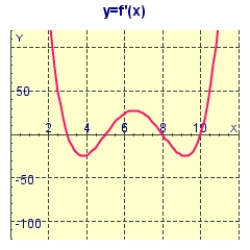
 of a function f is shown below. At what values of x does f have a local maximum or minimum?
of a function f is shown below. At what values of x does f have a local maximum or minimum? 

Unlock Deck
Unlock for access to all 68 flashcards in this deck.
Unlock Deck
k this deck
51
Verify that the function satisfies the three hypotheses of Rolle's Theorem on the given interval. Then find all numbers c that satisfy the conclusion of Rolle's Theorem. 
A)
B)
C)
D)
E)

A)

B)

C)

D)

E)


Unlock Deck
Unlock for access to all 68 flashcards in this deck.
Unlock Deck
k this deck
52
Find the number c that satisfies the conclusion of the Mean Value Theorem on the given interval.  ,
, 
A)
B)
C)

D)
E)None of these
 ,
, 
A)

B)

C)


D)

E)None of these

Unlock Deck
Unlock for access to all 68 flashcards in this deck.
Unlock Deck
k this deck
53
The function  satisfies the hypotheses of Rolle's Theorem on the interval
satisfies the hypotheses of Rolle's Theorem on the interval  . Find all values of c that satisfy the conclusion of the theorem.
. Find all values of c that satisfy the conclusion of the theorem.
A)-6, -4
B)-5, -4
C)-6
D)-5
 satisfies the hypotheses of Rolle's Theorem on the interval
satisfies the hypotheses of Rolle's Theorem on the interval  . Find all values of c that satisfy the conclusion of the theorem.
. Find all values of c that satisfy the conclusion of the theorem.A)-6, -4
B)-5, -4
C)-6
D)-5

Unlock Deck
Unlock for access to all 68 flashcards in this deck.
Unlock Deck
k this deck
54
At 4:00 P.M. a car's speedometer reads 25  . At 4:15 it reads 72
. At 4:15 it reads 72  . At some time between 4:00 and 4:15 the acceleration is exactly x
. At some time between 4:00 and 4:15 the acceleration is exactly x  . Find x.
. Find x.
 . At 4:15 it reads 72
. At 4:15 it reads 72  . At some time between 4:00 and 4:15 the acceleration is exactly x
. At some time between 4:00 and 4:15 the acceleration is exactly x  . Find x.
. Find x.
Unlock Deck
Unlock for access to all 68 flashcards in this deck.
Unlock Deck
k this deck
55
Find the critical number(s), if any of the function 
A)0,
B)
C)
D)0,

A)0,

B)

C)

D)0,


Unlock Deck
Unlock for access to all 68 flashcards in this deck.
Unlock Deck
k this deck
56
Find a cubic function  that has a local maximum value of
that has a local maximum value of  at 1 and a local minimum value of -1,184 at 7.
at 1 and a local minimum value of -1,184 at 7.
 that has a local maximum value of
that has a local maximum value of  at 1 and a local minimum value of -1,184 at 7.
at 1 and a local minimum value of -1,184 at 7.
Unlock Deck
Unlock for access to all 68 flashcards in this deck.
Unlock Deck
k this deck
57
Find the critical number(s), if any, of the function  .
.
A)
B)
C)None of these
D)
 .
.A)

B)

C)None of these
D)


Unlock Deck
Unlock for access to all 68 flashcards in this deck.
Unlock Deck
k this deck
58
Find the critical number(s), if any, of the function 
A)
B)
C)-4
D)

A)

B)

C)-4
D)


Unlock Deck
Unlock for access to all 68 flashcards in this deck.
Unlock Deck
k this deck
59
The function  satisfies the hypotheses of Rolle's Theorem on the interval
satisfies the hypotheses of Rolle's Theorem on the interval  . Find all values of c that satisfy the conclusion of the theorem.
. Find all values of c that satisfy the conclusion of the theorem.
A)
B)
C)
D)
 satisfies the hypotheses of Rolle's Theorem on the interval
satisfies the hypotheses of Rolle's Theorem on the interval  . Find all values of c that satisfy the conclusion of the theorem.
. Find all values of c that satisfy the conclusion of the theorem.A)

B)

C)

D)


Unlock Deck
Unlock for access to all 68 flashcards in this deck.
Unlock Deck
k this deck
60
Find the critical number(s), if any, of the function  .
.
A) and
and 

B) and
and 

C)
D)
 .
.A)
 and
and 

B)
 and
and 

C)

D)


Unlock Deck
Unlock for access to all 68 flashcards in this deck.
Unlock Deck
k this deck
61
Find the absolute minimum value(s) of ![Find the absolute minimum value(s) of on the interval [0, 6].](https://d2lvgg3v3hfg70.cloudfront.net/TB8390/11eb7c01_170d_4822_acd2_6918cf6bac9d_TB8390_11.jpg) on the interval [0, 6].
on the interval [0, 6].
![Find the absolute minimum value(s) of on the interval [0, 6].](https://d2lvgg3v3hfg70.cloudfront.net/TB8390/11eb7c01_170d_4822_acd2_6918cf6bac9d_TB8390_11.jpg) on the interval [0, 6].
on the interval [0, 6].
Unlock Deck
Unlock for access to all 68 flashcards in this deck.
Unlock Deck
k this deck
62
Sketch the graph of  on
on  and find its absolute maximum and absolute minimum values, if any.
and find its absolute maximum and absolute minimum values, if any.
 on
on  and find its absolute maximum and absolute minimum values, if any.
and find its absolute maximum and absolute minimum values, if any.
Unlock Deck
Unlock for access to all 68 flashcards in this deck.
Unlock Deck
k this deck
63
Find the absolute maximum and absolute minimum values, if any, of the function  on
on 
 on
on 

Unlock Deck
Unlock for access to all 68 flashcards in this deck.
Unlock Deck
k this deck
64
Find the maximum and minimum points of the function. 


Unlock Deck
Unlock for access to all 68 flashcards in this deck.
Unlock Deck
k this deck
65
Find the critical numbers of the function. 


Unlock Deck
Unlock for access to all 68 flashcards in this deck.
Unlock Deck
k this deck
66
Find all the critical numbers of the function. 


Unlock Deck
Unlock for access to all 68 flashcards in this deck.
Unlock Deck
k this deck
67
The graph below is the graph of function f on the interval  Find the absolute maximum and absolute minimum values of f (if they exist) and where they are attained.
Find the absolute maximum and absolute minimum values of f (if they exist) and where they are attained. 
 Find the absolute maximum and absolute minimum values of f (if they exist) and where they are attained.
Find the absolute maximum and absolute minimum values of f (if they exist) and where they are attained. 

Unlock Deck
Unlock for access to all 68 flashcards in this deck.
Unlock Deck
k this deck
68
Find the absolute maximum and absolute minimum values, if any, of the function  on
on  .
.
 on
on  .
.
Unlock Deck
Unlock for access to all 68 flashcards in this deck.
Unlock Deck
k this deck



